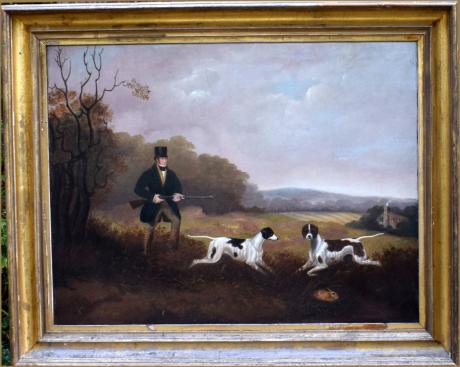The history of the Pointer, like many breeds, is a reasonably debatable topic. Records of Pointers in England trace as far back as 1650. According to one source, the Pointer came to be in the 16th and 17th centuries, when pointing breeds, including the Old Spanish and Portuguese pointer, were brought from the European mainland to England.
Through both history and anatomical evaluation, at least four breeds appear to have been instrumental in Pointer crosses: Greyhounds, Foxhounds, Bloodhounds, and Bull Terriers. Each of these were established breeds with unique qualities the Pointer could use to do its job.
Pointers were brought to the United States, where the breed flourished in the abundant open hunting land. At that time (late 1800s), the Setter was considered to be the bird-hunting dog and pointers were not even permitted to compete in field trials with setters. Around 1910, however, the Pointer began to beat the Setter at its own game. The Pointer has dominated the pointing breed field trials since then.
One of the earliest dogs to exert influence on the breed in the US was a dog imported from England in 1876 – "Sensation". He is well known as the dog on the emblem of the Westminster Kennel Club.
One modern American kennel, established in 1936, and known for breeding large quantities of Pointers, Elhew Kennels produced a popular and successful line of gun dogs. Elhew pointers were well-known competitors at field trials for several decades.
In the southern United States, where the dog is so dominant it is often simply referred to as the "bird dog," Pointers are found in abundance. The bobwhite quail is the primary game bird there, and is considered classic English Pointer game, as the bobwhite will hold well for a pointing dog. Pointers also work game birds such as the pheasant, grouse, and woodcock with success.
For an artist of such ability, popularity and wide output, information about Samuel Jones is comparatively scarce. Living in London, the first recorded mention of him was as an exhibitor at the Royal Academy in 1820 with a picture of an old mare, which he later exhibited at the British Institute in 1824.
Jones is best known for the fine quality of his sporting pictures, mainly portraits of hunting and work horses. In addition, he painted coaching, shooting, fishing, (an example of this being in the collection at Hutchinson House), and hunting scenes, paying much attention to the background landscapes. He also painted historical scenes and portraiture. His landscape works, often featuring cattle, were usually of views in Derbyshire, Kent, Sussex, Essex and Wales. Some of these were of substantial size and the Victoria and Albert Museum in London as a number of landscape sketches in its collection.
From notes made in two of his sketch books to be found in the British Museum, it can be seen that Jones thought that landscape painting was very important. This is reflected in the handling of trees and shrubs in his paintings. Wood, in his Dictionary of Animal Painters, says of him, “His landscape, by itself or as a setting for his sporting figures, is well-painted and commands
respect, being far superior to that of most animal painters, amongst whom he can hardly be numbered”.
His works were much engraved and published, the last being in 1849, and these were produced by Charles and George Hunt, Fellows, Hineley, Pyall and Smart.
Jones exhibited fourteen works at the British Institute, including views of watermills in Derbyshire and Kent. A further fourteen of his works were displayed at The Royal Academy including titles such as ‘The Lesson,” “Delightful Task” and “Born to Good Luck.” He also exhibited nineteen paintings at the Royal Society of British Artists in Suffolk Street.
He had two sons, Paul and Charles, who both became well-known landscape and animal painters
Bibliography
Dictionary of British Equestrian Artists - Sally Mitchell
A Dictionary of Artists 1760-1893 - Algernon Graves
Dictionary of British Landscape Painters - M H Grant
A Dictionary of British Animal Painters – J C Wood
Dictionary of Victorian Painters – Christopher Wood
Dog Painting 1840-1940 – William Secord



